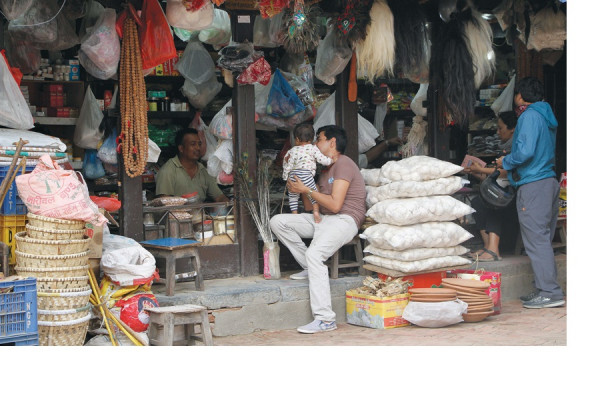DYA KHAA PASA : A TIME OLD EMPORIUM

The series of stores, right around the corner of Patan Durbar Square, looks like it is stuck in time. Nothing has changed about them; except maybe the people who stay behind its counter and those who visit it. It contrasts vastly from the surrounding hustle and bustle of the busy commercial area with two-wheelers zooming past and tuktuks waiting for passengers.
These stores are DyaKhaapasa: (pasa: meaning shop in Newari), traditional shops that sell anything from food items to medicinal herbs and essentials for religious rituals. Rumors have it that it originated from the first shopkeeper who was a left-handed man. In Newari, “Dekhaa” is used to denote a left-handed person. When people referred to the store, they would call it Dekhaa’spasa: and with time the name evolved into the DyaKhaapasa: Today, most old and rustic shops that sell herbal and ayurvedic remedies along with dried fruits and ritualistic objects in Patan are commonly known as a

DyaKhaapasa:
The stores’ exterior is a rustic structure of wooden pillars and shutters. On the inside, the walls are stacked to the ceiling with spices, herbs, sweets, nuts, oils, ointments, etc. It is a sensory overload, with its surrounding space filled with a strong aroma.
We take you on a journey to understand the significance of these stores.
An Apothecary
Perhaps, the best way to understand DyaKhaapasa: is to compare them to an apothecary. As herbal pharmaceuticals, these stores were as important as hospitals; their shopkeepers were pharmacists or almost doctors. My mother recalls visiting these stores, located in the same place as they are today, “Maa (mother) used to ask me to get paachak (digestive pills) for her stomach ache.” In older times, when hospitals and doctors where unheard of, people would buy necessary herbs and spices from these DyaKhaapasa:s to prepare medicines that would cure their ailment. Even today, a nutritious Ayurvedic formula is given to new mothers are still made and found in these DyaKhaapasa: just like olden times.
Solution to gastritis and balm for backaches are concocted here and sold to ailing individuals. My mother who has been a regular customer at these stores since her younger days shares that little has changed in the ways of DyaKhaapasa:s. “Perhaps the only change is the packaging,” she comments, “Before, the packaging used to be in paper, now, it is plastic.” Regardless of the packaging, the content still works wonders.
The herbal remedies of the DyaKhaapasa: are brought from sources as traditional as the shops themselves. These remedies are often brought from traditional ayurvedic manufacturers of Patan, the Vaidyas. The store also has products made from local businesses. Often, customers won’t even find the items displayed in the DyaKhaapasa: anywhere else.

Everything for a Ritual
Patan takes pride in its culture and rituals. There is at least one big puja happening somewhere in Patan, in a household. The DyaKhaapasa: is a one stop answer to all things ritualistic. From cotton threads, peacock feathers, butter lamps to customary items like jajanka (a threaded garland), aakhya (rice seeds used in pujas), and fish for swogan(good luck)can be found in there. Even back in the days, when people managed to prepare most of these puja items in their convenience of their homes, DyaKhaapasa:s were an inescapable part of their routine.
All things Food
Every year during Tihar, my mom makes a mental note of all things she will need for the festival. This includes puja items and mandatory edible goodies like walnuts, fishes, bags of masala, etc. Regardless of her note, she always forgets a few items. It is always the DyaKhaapasa: that comes to the rescue. The storekeeper puts forth the essential items and simply asks of how many of each item is required. It is an amazing exchange to witness and one that remains endearing after all these years. DyaKhaapasa: is still a popular store for many Patan denizens. Where else would you otherwise find delicacies such as dried apricots, figs, and peaches?

The DyaKhaapasa: are worn by time, but they are a magical emporium nonetheless. Business is perhaps slow due to urbanization, but their values stay strong. A DyaKhaapasa: is perhaps not even as big as a quarter of an aisle in a big supermarket, but is a wonderous world of its own. It is amazing to watch its storekeepers whip out items from unseen compartments of the cupboard as you list them out. It is equally interesting to watch them still use double-sided beam balance to measure little portions of miniscule products. And as the world whizzes pass them, DyaKhaapasa:s are a note captured in a time-capsule that narrates the old way of life.
